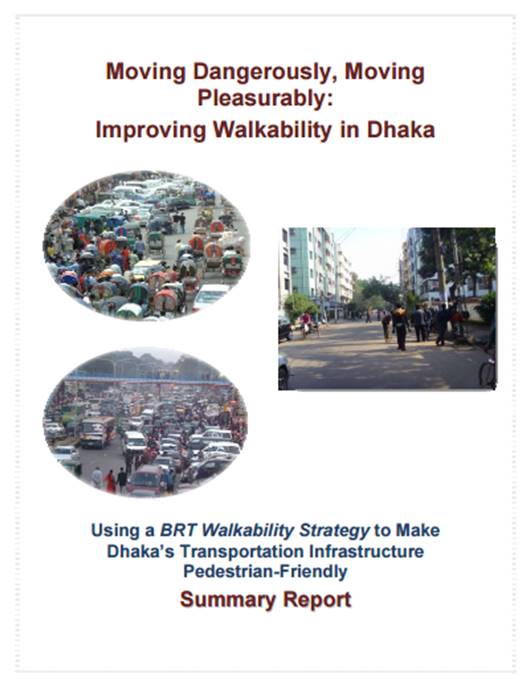Dehli announced a major new Complete Streets program that will redesign urban roads to favor walking, cycling and public transport over car traffic. This is very good news. It shows that the Complete Streets concept is now being applied worldwide.,

I am a great advocate of Complete Streets, which means that urban roadways are designed to accommodate diverse users and uses, including walking, cycling, public transit, plus nearby residents and businesses, in addition to automobile traffic. This increases urban transportation efficiency and equity by ensuring that all travel modes are safe and convenient.
This is a major paradigm shift, a fundamental change in the way problems are defined and potential solutions evaluated, from automobile-oriented to multimodal. Complete Streets planning has been widely embraced by North American professional organizations such as the Institute of Transportation Engineers, but is not as well established in developing countries, at least, not yet. Delhi, India's new plan to redesign ten major city roads to favor walking, cycling and public transit over automobile travel is very good news. It shows that the Complete Streets concept is making inroads in India and other Asian countries. This is a huge change and an important opportunity for improving the safety and livabilty of all residents, particularly lower-income people who walk and bike. I hope this project is successful and becomes an example for other cities in India and around the world.
Asian planners have developed some terrific multi-modal roadway design resources:
Moving Dangerously, Moving Pleasurably: Improving Walkability in Dhaka; Using a BRT Walkability Strategy to Make Dhaka’s Transportation Infrastructure Pedestrian-Friendly by the Asian Development Bank.

Changing Course in Urban Transport- An Illustrated Guide by the Sustainable Urban Transport Project and GIZ.

Better Street, Better Cities: A Guide To Street Design In Urban India by the Institute for Transportation and Development Policy.

Mobility For All A Strategic Transportation Plan For Ranchi by the Institute for Transportation and Development Policy for the Ranchi Mobility Partnership.

Walkability and Pedestrian Facilities in Asian Cities: State and Issues, Sustainable Development Working Paper, Asian Development Bank.

Safety, Sustainability and Future Urban Transport by the Eicher Group.

Working Group on Urban Transport Final Report by the National Transport Policy Development Committee, Ministry of Urban Development (MoUD), Government of India.

Pedestrian Design Guidelines: Don’t Drive…Walk by the Delhi Development Authority, New Delhi.

Walkability Asia supports walkability improvements in Asian countries.
Traffic & Transportation Policies and Strategies in Urban Areas in India by the India Ministry of Urban Development.

Environmentally Sustainable Transport For Asian Cities: A Sourcebook by the United Nations Centre for Regional Development.

Istanbul: An Accessable City – A City For People by EMBARQ Turkey .

These are world-class resources that should be useful to Complete Streets advocates everywhere. Congratulations to my colleagues in India. Well done and good luck!

Planetizen Federal Action Tracker
A weekly monitor of how Trump’s orders and actions are impacting planners and planning in America.

Chicago’s Ghost Rails
Just beneath the surface of the modern city lie the remnants of its expansive early 20th-century streetcar system.

Amtrak Cutting Jobs, Funding to High-Speed Rail
The agency plans to cut 10 percent of its workforce and has confirmed it will not fund new high-speed rail projects.

Ohio Forces Data Centers to Prepay for Power
Utilities are calling on states to hold data center operators responsible for new energy demands to prevent leaving consumers on the hook for their bills.

MARTA CEO Steps Down Amid Citizenship Concerns
MARTA’s board announced Thursday that its chief, who is from Canada, is resigning due to questions about his immigration status.

Silicon Valley ‘Bike Superhighway’ Awarded $14M State Grant
A Caltrans grant brings the 10-mile Central Bikeway project connecting Santa Clara and East San Jose closer to fruition.
Urban Design for Planners 1: Software Tools
This six-course series explores essential urban design concepts using open source software and equips planners with the tools they need to participate fully in the urban design process.
Planning for Universal Design
Learn the tools for implementing Universal Design in planning regulations.
Caltrans
City of Fort Worth
Mpact (founded as Rail~Volution)
City of Camden Redevelopment Agency
City of Astoria
City of Portland
City of Laramie





























